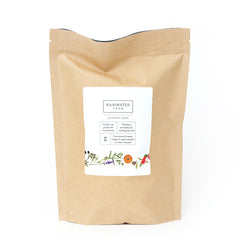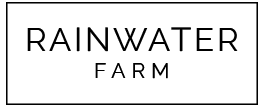Laundry Room Detox

Over the past few years we’ve had so many conversations with friends and customers about the (exciting and glamorous!) topic of… laundry detergent. We meet people all the time who suffer from chronic dry skin and itchiness. Sometimes they (or their child) might be constantly fighting more aggressive skin dermatitis such as psoriasis and eczema. And in some cases, we’ve encountered parents whose children struggle with asthma and respiratory issues and are trying to pinpoint any household environmental factors that could be exacerbating it. One of our first suggestions is always to change the way they clean their laundry, and unsurprisingly, these same customers eventually call, email, or come back to share with us how big of a difference it made for them.
As we all become more thoughtful with the types of cleaning products, soaps and skincare products we use, eliminating or replacing the items in our showers, medicine cabinets, and makeup drawers--the laundry room goes largely unnoticed and untouched. This is understandable! It’s not easy to even find the ingredients in a box or jug of laundry detergent or fabric softener--much less figure out more natural substitutes or even where to buy those.
So, today we’re going to break down the entire topic of laundry detergent and how (and why!) you should think about a full-scale Laundry Room Detox! We’ll talk about some of the most common ingredients in laundry detergent and fabric softeners, and also share some tips and tricks. Ultimately, we love sharing information that has helped so many people already, and can help you and your family find relief from skin and respiratory issues while reducing your daily exposure to chemicals and compounds that, over time, can be harmful for your bodies and skin.
Why Should I Consider A Laundry Room Detox?
Consider overhauling all of your laundry products and switching to natural soaps and solutions if you:
- struggle with consistent skin irritation or chronically dry skin- have a family member or child who suffers from eczema or psoriasis
- have a family member or child who struggles with asthma or other respiratory issues (and take a look at this study from the University of Washington, which measured dryer vent emissions and identified toxic and carcinogenic VOCs caused by the ingredients in detergents and fabric softeners)
- launder cloth diapers or clothes for newborns and babies
- find that your clothes often feel stiff, or tend to emit trapped odors (have you ever washed workout clothes just to find that they start smelling bad once you put them on again?)
- have concerns about the environmental impact typical laundry chemicals and detergents have on the environment, particularly the aquatic ecosystem
What ingredients are in laundry detergents and fabric softeners?
1,4 Dioxane: This isn’t an ingredient actually, it’s a byproduct of a process used in the creation of sodium lauryl sulfate (or, SLS). At worst--it’s a very probable carcinogen and can cause damage to the central nervous system and internal organs. At best, it is irritating to the eyes, respiratory tract, and skin, as outlined by this CDC fact sheet. Bottom line, 1,4 Dioxane poses too large of a risk for anyone to want it in contact with their skin day in and day out.
Phosphates: Phosphates are compounds that help the cleaning components of the detergent to act, in effect, softening the water and preventing the mineral ions in water from blocking the cleaning action. This all sounds great, right? Well, unfortunately, water treatment processes do not remove these phosphates from the water supply--and a large amount of these compounds are released into streams, lakes and rivers. Once they are in the water system, these compounds greatly accelerate the natural growth of organic material in the water system which in turn strips oxygen from lakes and rivers, making the water uninhabitable for fish and other aquatic life. Long story short, phosphates in detergents are doing a number on our natural environment, and while the EU has already taken strong steps to eliminate phosphates from laundry products, the US is far behind. (This paper from the University of Colorado is a great resource for anyone wishing to take a deeper look)
Nonylphenol Ethoxylate (or NPEs): NPEs are found mostly in industrial cleaners and is yet another petrochemical. Similar to parabens and BPA, they mimic the hormone estrogen and are endocrine disruptors, which as defined by the National Institute of Environmental Health Sciences, are “chemicals that may interfere with the body’s endocrine system and produce adverse developmental, reproductive, neurological and immune effects in both humans and wildlife.” NPEs do not easily or quickly biodegrade, and according to the EPA, they are "extremely toxic" to aquatic organisms.
Dyes and Fragrances: We all want our laundry to smell fresh and lovely, but at what cost? Surprisingly, there is no real regulation of the word “fragrance,” meaning the chemical cocktail of compounds used to achieve the smell of Fresh Rain or Clean Cotton do not have to be disclosed by manufacturers. (And, even more troublesome: many "Fragrance Free" detergents aren't really fragrance free, they just have added additional chemicals to mask any smell). One of the troublesome substances in fragrances (from cosmetics and soaps to laundry detergents and dryer sheets) are pthalates, which are probably carcinogens and endocrine disrupters. At the very least, we’ve found that these fragrances can be highly irritating: causing itchy, irritated skin and exacerbating any existing dermatitis. Take a look at Nicholas Kristof’s article in the New York Times about pthalates and other endocrine disrupters if you’re interested in learning more!
Optical Brighteners: If you’ve seen the detergent commercials that claim “Whites look whiter, and brights look brighter,” then you are probably already familiar with optical brighteners. These brighteners can be synthesized using a wide variety of chemicals and they can vary from product to product, but if you’d like to read up on some of the most common ones, this article has a good rundown.
How can I detox my laundry room? What are good, non-toxic substitutes for laundry detergents, fabric softeners, and dryer sheets?

Rainwater Farm Natural & Fragrance-Free Laundry Soap
One thing we do NOT want is for a laundry room detox to feel overwhelming, so we’re sharing some simple tricks and steps that will help you have fresh laundry, cleaner air, and healthier skin.
Use a laundry soap, not a laundry detergent: Here at Rainwater Farm we do make a fragrance-free, natural, and non-toxic laundry soap. It is highly concentrated and compatible with both standard and HE machines. You can buy it here, or, if you’re up for trying to make your own detergent there are many recipes out there for you to follow. Just make sure you’re grating or grinding a natural, pure soap, castile or otherwise: not a standard bar of grocery store soap. We sell bars of gentle and unscented soap here as well (which also, I might add, makes for an amazing stain remover or pre-treater!).
Use essential oils for lovely-smelling laundry: I personally don’t need my laundry to smell like anything but clean. But, for those who might want a little extra fragrances, use a few drops of your favorite essential oil during the rinse cycle!
Use Borax or washing soda: When you do use your natural laundry soap, be sure to add Borax or Washing Soda. Both are available for a few dollars at your local grocery store, and are a gentler, environmentally-friendly way to soften and condition your water to allow dirt to be pulled out of your clothes and be washed away. Use even if you have a water softener or naturally soft water--and definitely use if you have hard water!
Use warm or hot water: Whenever possible, use warm or hot water with your laundry soap, to enhance the soap’s effectiveness.
Use wool dryer balls: We actually think you’ll notice a difference in the stiffness of your laundry just by using a natural laundry soap a few times. But, if you’d like to replace your fabric softener, use these felt or wool dryer balls in your dryer, especially for baby clothes or cloth diapers!
Questions, comments, or tips of your own? Did we miss anything? Have you noticed a difference since switching to natural laundry products? We'd love to hear in the comments!
Next →
← Previous
3 Responses
Kaye Sandridge
I am using your laundry powder with washing soda in my top load HE warm or hot water.
Some of the soap remains in the tray after washing. It becomes hard. Any advise is appreciated!
CAROL SEWELL
Do you speak to groups about your mission?

Rainwater Farm
May 25, 2022
Hi Kaye, one thing we suggest if you have this problem is to dissolve your laundry soap and washing soda in water before adding to your washer. This should solve the problem!